- Japonisme Art in France
- Japonisme Artworks after Impressionism
- Japonisme Artworks after Impressionism
- Japonisme Characteristics
- Impact of Japanese Art in the New Century: Calligraphy, Manga, and Anime
- Impact of Japanese Art in the New Century: Calligraphy, Manga, and Anime
- The Term Japonisme
- Japonisme Examples of Impressionism
Western artists have long been fascinated and inspired by Japanese art, the craze and influence of art and design coming from Japan being known as Japonism, or French “Japonisme”. After the Dutch imported East Asian objets d’art in the 17th century, wealthy Europeans became obsessed with Japanese print art, woodblock prints, exotic silks, porcelains like Japanese teapots, and other treasures. Japan had an exclusive trade agreement with the Dutch during this period, but when American Commodore Matthew Perry arrived with war vessels in Edo Bay in 1853, he ended 250 years of near isolation, allowing the world to trade with the country.

Japonisme Art in France
After Japan had reopened to the West, shiploads of oriental products began pouring into the US and Europe, especially into France. Far Eastern curio shops mushroomed in Paris, selling fans, kimonos, Japanese print art, lacquered boxes, ceramics, brush paintings, hanging scrolls, bronze statuary, and many other items. Stores like these gained even more traction after Japan held its first formal arts and crafts exhibition at the Paris World Fair in 1867, which attracted a great deal of interest. In attendance were proponents of an emerging group of avant-garde artists, which would become known as the Impressionists.
How was Impressionism influenced by Japanese woodblock print? The group of artists was particularly taken with the fine, multicoloured ukiyo-e woodblock prints, which many of them collected. Ukiyo-e, literally meaning “Pictures of the Floating World”, refers to a style of print and painting from the Japanese Edo period in the 18th and 19th century, mostly depicting city life, romantic landscapes, theatre actors, beautiful courtesans, and erotic scenes. The so-called Floating World was the pleasure district of Edo, modern-day Tokyo, and the ukiyo-e described the sensory indulgences of the urban life, at the same time reminding of the transient nature of worldly pleasures. This kind of Japanese print art was mass-produced as woodcuts and was affordable for the average person. Among the master printmakers from this period were artists such as Utagawa Hiroshige, Kitagawa Utamaro, and Katsushika Hokusai.
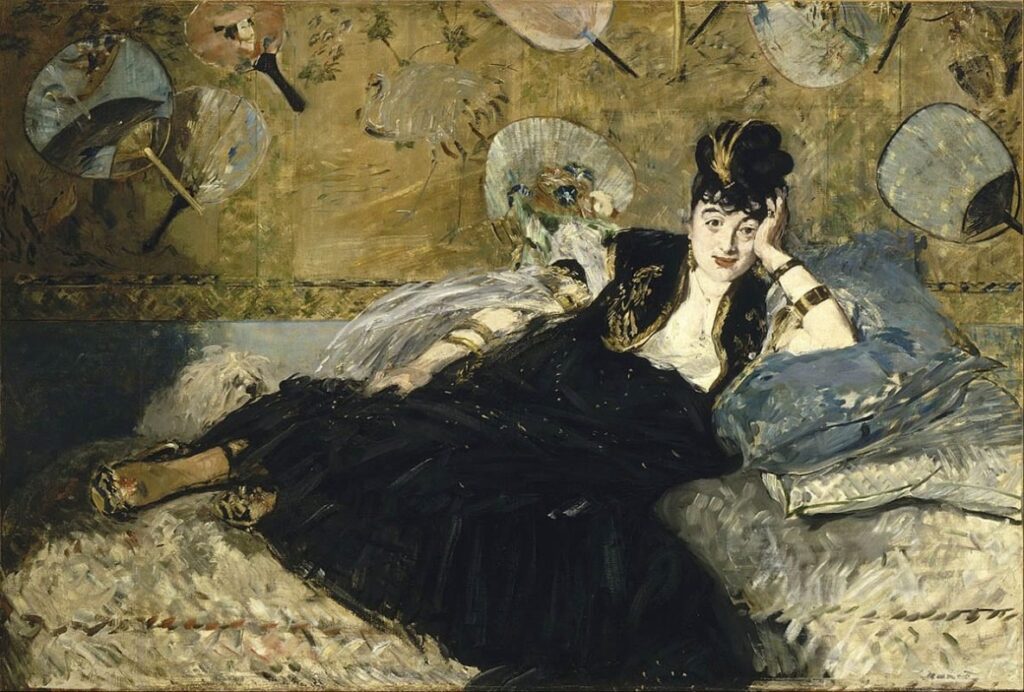
Japonisme Characteristics
Japonisme Definition: Both the motifs and the techniques used in ukiyo-e had a strong impact on the Impressionists. Between the 1860s and the 1890s, they adopted the Japanese woodblock codes and experimented with the new techniques. They further began integrating Japanese-style decors and objects into their artworks, adopted new formats such as the vertical hanging wall scroll, and imitated the images with their focus on nature and everyday scenes. Besides using broad planes of colour instead of point perspective and extreme cropping, further key characteristics of the prints were:
- Shapes were emphasised by using dark outlines, the choice of colours would often be abstract, unrealistically applied.
- The elements had only limited depth resulting in a flattened picture plane. Generally flat areas of non-modulated colour were used.
- Strong contrasts of light and dark, chiaroscuro, were avoided, but negative space, the composition of empty spaces emphasized.
- Compositions would usually be asymmetrical, emphasizing the diagonal and unusual viewpoints.
- Most pictures included calligraphy and the artist’s stamp as a signature.
The Term Japonisme
By 1876, the Japanese style had so strongly imbued French intellectuals, artists and the entire society, that a new term was coined by the French journalist and art critic Philippe Burty in an article published in 1876 to describe the craze for all things Japanese: Japonisme.
Japonisme characteristics transformed the style of the Impressionism and Post-Impressionism movements by demonstrating that simple, everyday subjects could be presented in intriguing ways, giving them new directions of painting and printmaking. As with the technique of photography, the ukiyo-e inspired style contributed significantly to the “snapshot” effect and unconventional angles which became emblematic for both art movements.
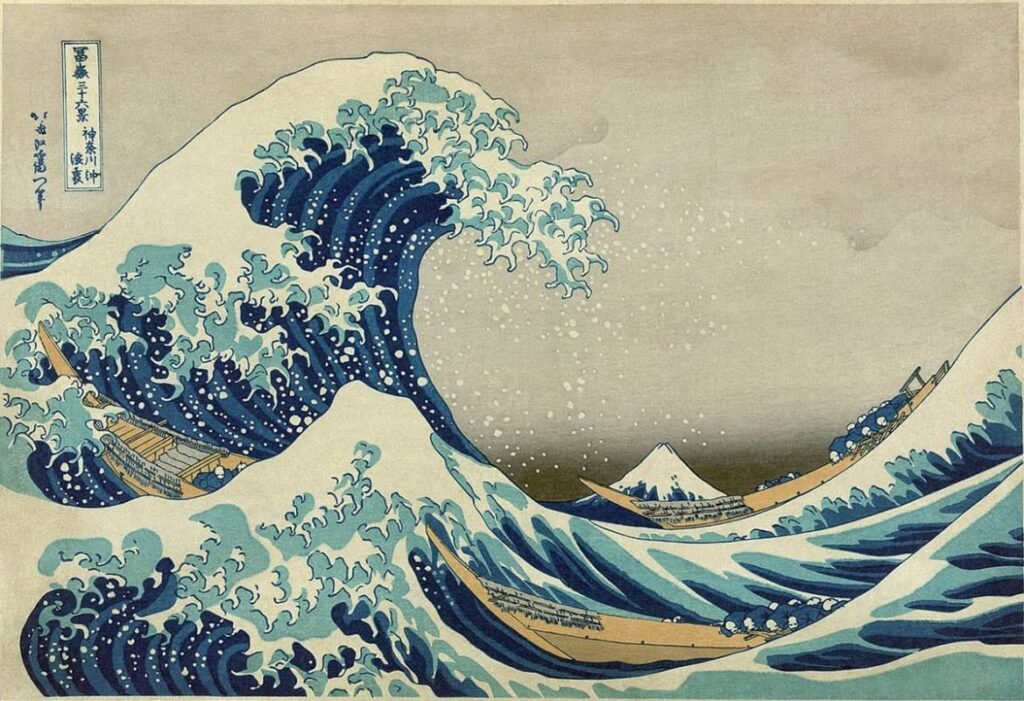
Japonisme Examples of Impressionism
Who were some of the Japonisme artists and what are some examples of Japonisme art? It is believed that Gustave Courbet, who paved the way for the movement of Impressionism in France, had seen the famous colour woodcut “The Great Wave off Kanagawa” by Japanese artist Katsushika Hokusai before he painted a series of the Atlantic Ocean in 1869. The Japanese picture had changed Courbet’s understanding of aesthetics: While at his time European artists used to idealize the beauty of nature, Courbet instead depicted the stormy and tormenting nature of the sea with all its forces at work. This representation was deeply disturbing for the academic traditionalist of the Salon de Paris.
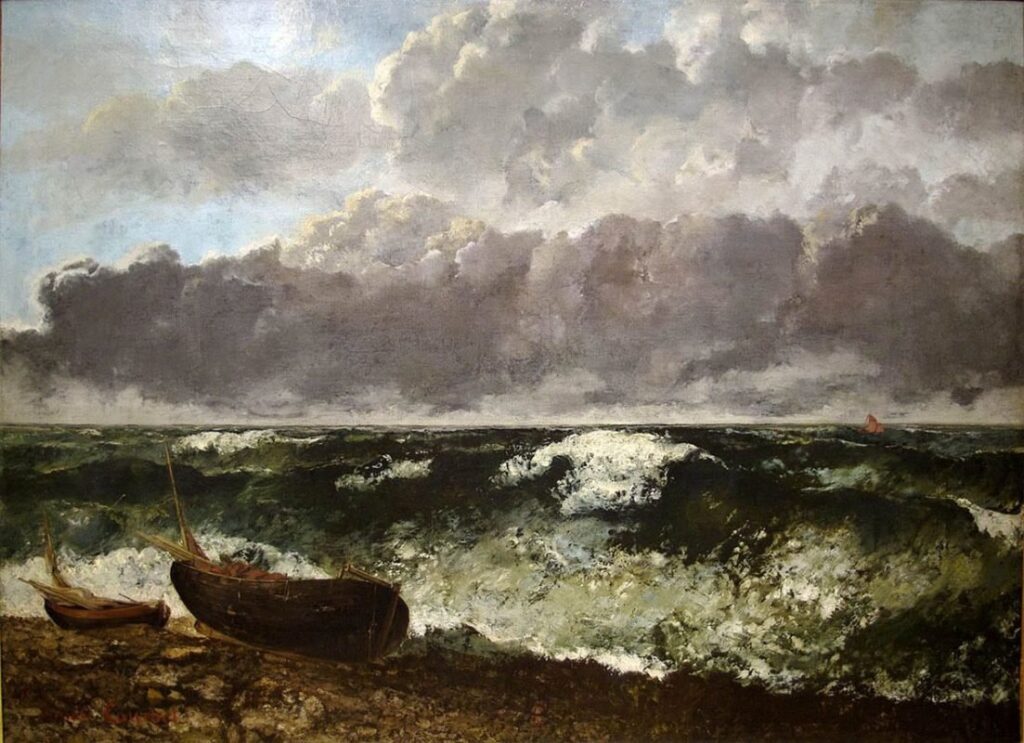
Edgar Degas, Japonisme: Edgar Degas began to collect Japanese prints from small print shops in Paris, which served him as a source of inspiration. Similar to Japanese artists, he strongly focused on women and their daily routines, positioning his subjects atypically, which aligned him with Japanese print artists such as Utamaro and Hokusai. Their influences were further reflected in many of his compositions including his drawings and Japonisme paintings. His images of dancers often seemed to be cropped, while his subjects wouldn’t appear to be posed, rather representing a scene from an ordinary dancers’ rehearsal, giving the viewer the impression that this is just a snapshot in time. He further applied large areas of homogenous colour as can be seen in the floor, the walls, and the dancers’ tutus.
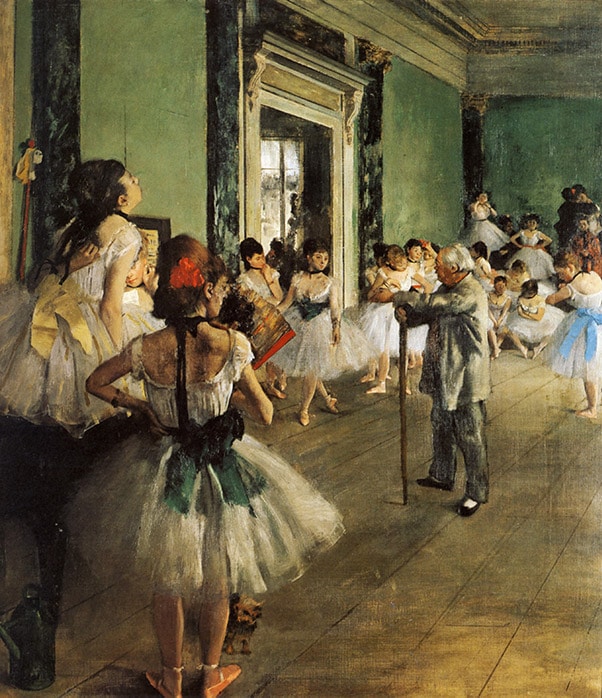
Mary Cassatt, Japonisme: Degas’ American friend Mary Cassatt was especially interested in depicting women and children in her prints, people going about their daily activities. While most of her subject matter was not Oriental, she occasionally featured a woman holding a fan. She was mostly inspired by the woodcuts of Kitagawa Utamaro, producing numerous colour etchings in open admiration of his compositions and technical innovations.
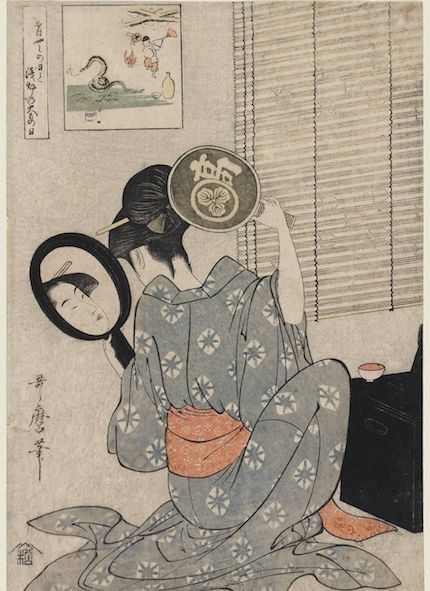
Claude Monet, Japonisme: Claude Monet amassed a collection of more than 200 Japanese prints throughout his career, which had a strong impact not only on his art but his entire life. He deeply admired how nature played a decisive role in Japanese culture and created a Japanese garden in his home in Giverny. He turned a small pond into an Asian-influenced water garden and added a traditional Japanese wooden bridge. Over many years he painted the pond with its water lilies numberless times, creating paintings that later became his most appreciated and well-known artworks.
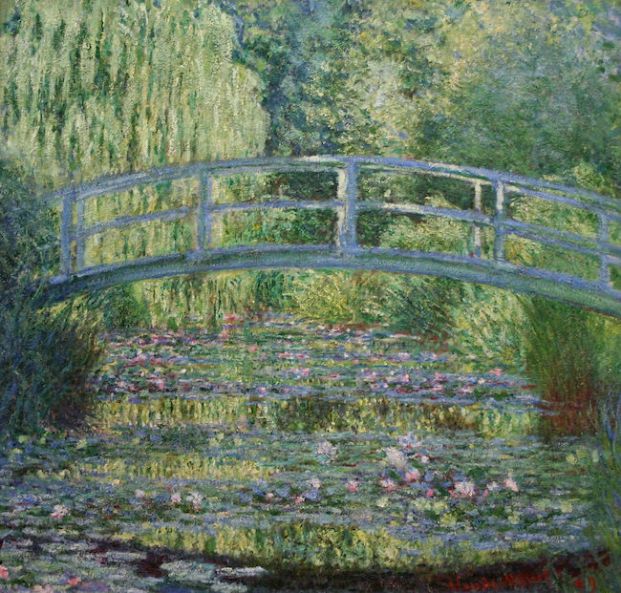
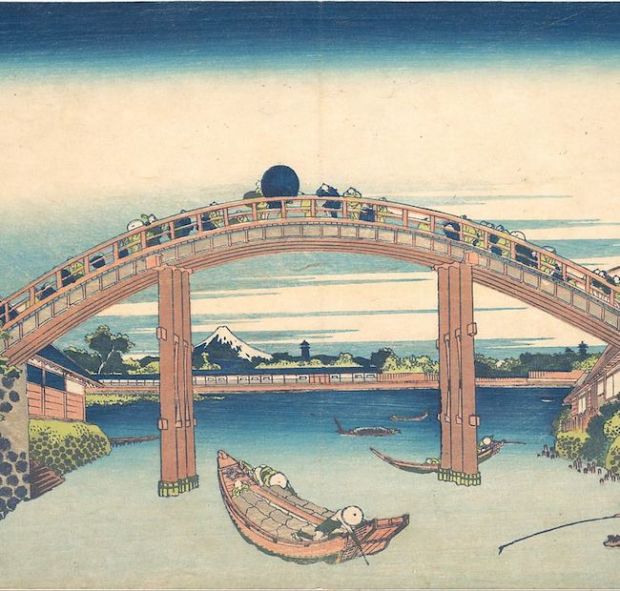
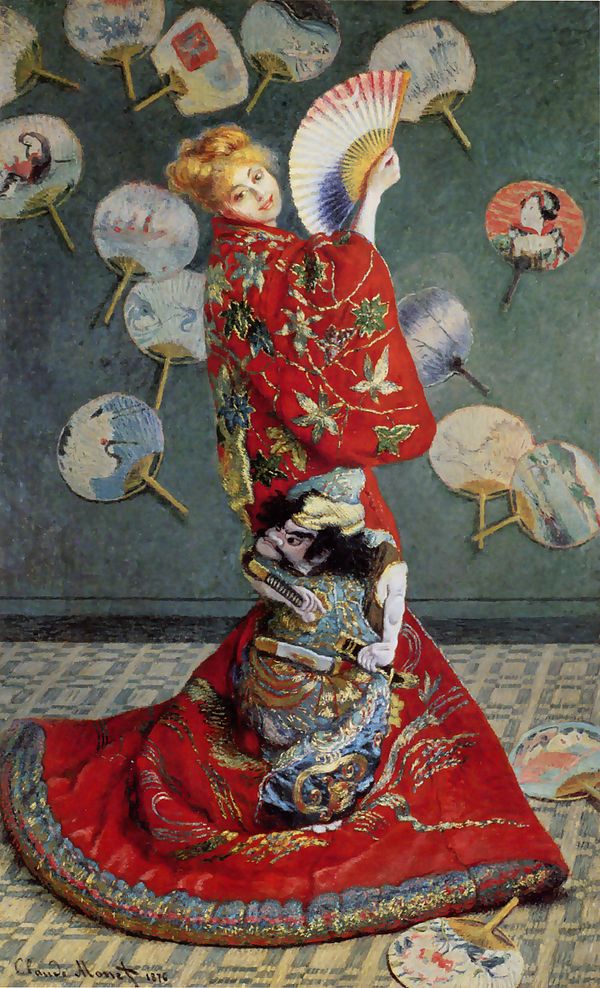
Van Gogh, Japonisme: Like his fellow artists, Vincent van Gogh collected a large number of Japanese prints and later began to deal in them with his brother Theo. He developed an idealised conception of the Japanese artist which led him to the attempt to form a utopian art colony, today known as the Yellow House of Arles. Van Gogh was inspired by the style of the Japanese wood prints, especially the cropping of compositions, the bold, assertive outlines, unusual perspectives, and the emphasis on decorative patterns. He further made copies of some of the imagery, among them Hiroshige’s and Keisai Eisen’s prints.
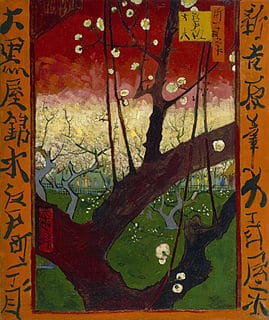
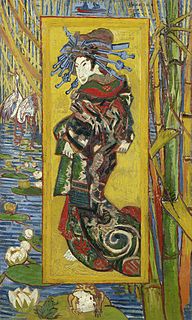
The list of further artists of Impressionism and Post-Impressionism inspired by Japanese art is long and includes famous names such as Édouard Manet, James McNeill Whistler, Pierre-Auguste Renoir, Camille Pissarro, and Paul Gauguin.
Japonisme Artworks after Impressionism
Gustav Klimt, Japonisme: Transitioning into the movement of Art Nouveau, Gustav Klimt too was inspired by the coloured ukiyo-e prints, the evidence being most evident in the flat planes, vivid colours, and intricate patterns of his works. He further was a great admirer of the Rinpa School of Kyoto, known for their refined style and especially the use of gold leaf backgrounds, which Klimt translated throughout his “Golden Phase” into his own imagery.
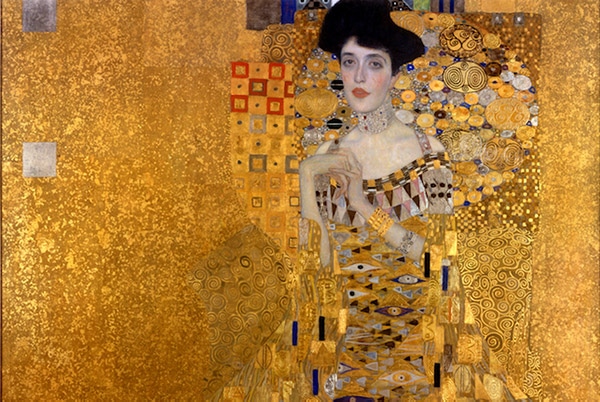
Toulouse-Lautrect, Japonisme: Another artist of Art Nouveau, Henri de Toulouse-Lautrec, similarly experimented with a wide range of pictural modes and with printmaking techniques during the 1890s. He adopted the exaggerated contours, colours, and further facial expressions found in Kabuki theatre prints for his own creation of eye-catching posters. Toulouse-Lautrec favoured the subject matter of the brothels and dance halls of Montmartre, representing a European equivalent of Edo’s pleasure districts.
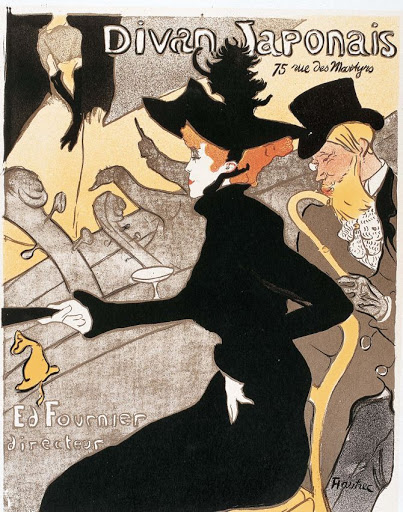
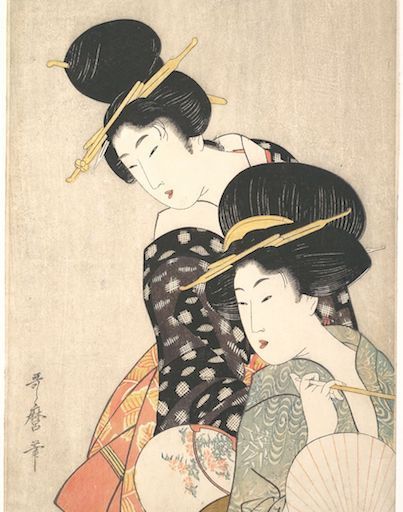
Impact of Japanese Art in the New Century: Calligraphy, Manga, and Anime
The influence of Japanese art kept fascinating Western artists also after the turn of the century. However, the centres of interest got broader, especially spreading to New York and other parts of the US. Many artists of the American movement of Abstract Expressionism such as Frank Kline, Willem de Kooning and Jackson Pollock used sweeping brush strokes inspired by Japanese and Chinese calligraphy throughout the 1940s and 1950s.
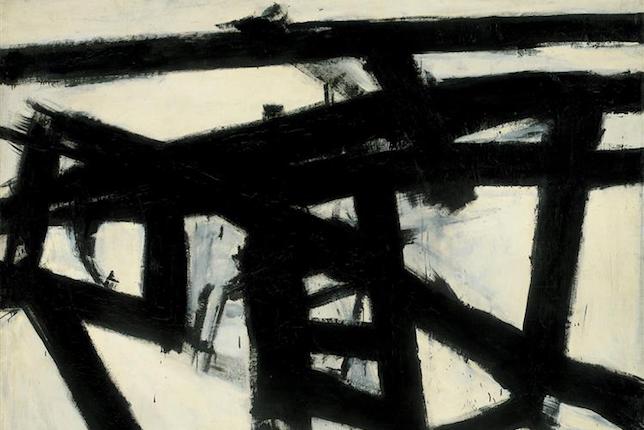
In the time of contemporary art, the fascination with Japanese art shifted towards manga and its animated form anime. Beginning in the mid-1990s, artists in France developed a deep appreciation for the Japanese form of comics. Furthermore, Japanese contemporary artists such as Takashi Murakami saw a major rise in popularity during the same period, introducing kawaii aesthetics – known for cute characters in pastel colours – to Western artists. For example, Caroline Maurel and Arno Metz have embraced this modern style of Japanese art in their paintings, continuing this art form in their own way.
You might also be interested in the following articles by Pigment Pool:
Exhibitions to See in Australia in the second half of 2021
A brief history of colour pigments
Best Japonisme book recommendations:





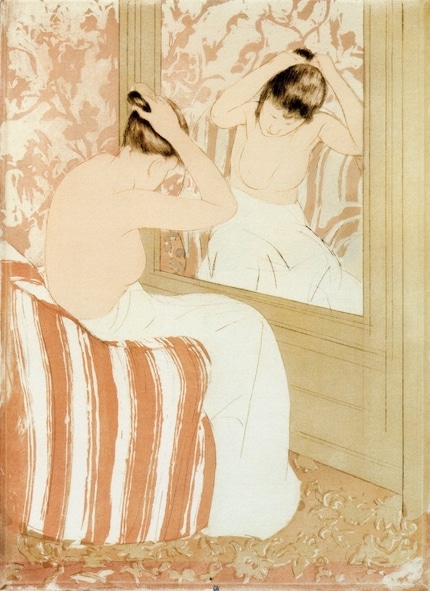

Claude Monet, Japonisme: Claude Monet amassed a collection of more than 200 Japanese prints throughout his career, which had a strong impact not only on his art but his entire life. He deeply admired how nature played a decisive role in Japanese culture and created a Japanese garden in his home in Giverny. He turned a small pond into an Asian-influenced water garden and added a traditional Japanese wooden bridge. Over many years he painted the pond with its water lilies numberless times, creating paintings that later became his most appreciated and well-known artworks.



Van Gogh, Japonisme: Like his fellow artists, Vincent van Gogh collected a large number of Japanese prints and later began to deal in them with his brother Theo. He developed an idealised conception of the Japanese artist which led him to the attempt to form a utopian art colony, today known as the Yellow House of Arles. Van Gogh was inspired by the style of the Japanese wood prints, especially the cropping of compositions, the bold, assertive outlines, unusual perspectives, and the emphasis on decorative patterns. He further made copies of some of the imagery, among them Hiroshige’s and Keisai Eisen’s prints.


The list of further artists of Impressionism and Post-Impressionism inspired by Japanese art is long and includes famous names such as Édouard Manet, James McNeill Whistler, Pierre-Auguste Renoir, Camille Pissarro, and Paul Gauguin.
Japonisme Artworks after Impressionism
Gustav Klimt, Japonisme: Transitioning into the movement of Art Nouveau, Gustav Klimt too was inspired by the coloured ukiyo-e prints, the evidence being most evident in the flat planes, vivid colours, and intricate patterns of his works. He further was a great admirer of the Rinpa School of Kyoto, known for their refined style and especially the use of gold leaf backgrounds, which Klimt translated throughout his “Golden Phase” into his own imagery.

Toulouse-Lautrect, Japonisme: Another artist of Art Nouveau, Henri de Toulouse-Lautrec, similarly experimented with a wide range of pictural modes and with printmaking techniques during the 1890s. He adopted the exaggerated contours, colours, and further facial expressions found in Kabuki theatre prints for his own creation of eye-catching posters. Toulouse-Lautrec favoured the subject matter of the brothels and dance halls of Montmartre, representing a European equivalent of Edo’s pleasure districts.


Impact of Japanese Art in the New Century: Calligraphy, Manga, and Anime
The influence of Japanese art kept fascinating Western artists also after the turn of the century. However, the centres of interest got broader, especially spreading to New York and other parts of the US. Many artists of the American movement of Abstract Expressionism such as Frank Kline, Willem de Kooning and Jackson Pollock used sweeping brush strokes inspired by Japanese and Chinese calligraphy throughout the 1940s and 1950s.

In the time of contemporary art, the fascination with Japanese art shifted towards manga and its animated form anime. Beginning in the mid-1990s, artists in France developed a deep appreciation for the Japanese form of comics. Furthermore, Japanese contemporary artists such as Takashi Murakami saw a major rise in popularity during the same period, introducing kawaii aesthetics – known for cute characters in pastel colours – to Western artists. For example, Caroline Maurel and Arno Metz have embraced this modern style of Japanese art in their paintings, continuing this art form in their own way.
You might also be interested in the following articles by Pigment Pool:
Exhibitions to See in Australia in the second half of 2021
A brief history of colour pigments
Best Japonisme book recommendations:





10 Lesser-Known Impressionist Artists You Must Discover: Beyond Monet and Renoir
Impressionists and Photography: How the Camera Changed Art Forever
20 Gorgeous Chinese Art Tattoos That Will Make You Want to Get Inked
